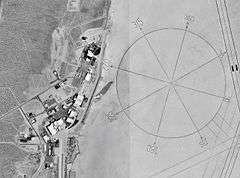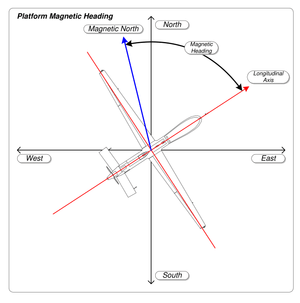Course (navigation)

In navigation, an object's course is the direction over the ground along which the object is currently moving.
Course, track, route and heading
The line connecting the object's consecutive positions on the ground is referred to as the ground track. The track the object was intended to follow is called the route. For ships and aircraft, the route is represented by the great circle line that connects the previous waypoint with the next waypoint. The responsibility of a navigator is to make the track coincide as much as possible with the route. The direction of the route is called the route course. "Course" exceptionally, and arguably erroneously, may also refer to the route, such as in a course deviation indicator, in which case it no longer constitutes an angle but rather a line. The direction of the great circle line that runs from the current position to the next waypoint is called the course to steer, or the bearing to that waypoint. The tracking angle is the angle between the course to steer and the course. The heading is the direction to which the "nose" of the object is pointing, its orientation.[1]
Directions (course to steer, course, heading and route course) are typically measured clockwise from north, either true or magnetic, in degrees from 0° to 359°, following compass convention (0° being north, 90° being east, etc.). In aviation, north is usually expressed as 360° instead of 0° [2] [3] . For land based vehicles (like cars), heading and course are typically identical, but for aircraft the action of wind, and for vessels the actions of wind and current may cause the two to differ significantly.
Relationship between true and magnetic direction
.svg.png)
- Heading (2) is the angle between the direction in which the object's nose is pointing and a reference direction (e.g. true north (1)) (the heading of the ship shown in the image above is about 060°).[4]
- Any reading from a magnetic compass refers to compass north (4), which is supposed to contain a two-part compass error:
- a) The Earth's magnetic field's north direction, or magnetic north (3), almost always differs from true north by magnetic variation (6), the local amount of which may be found in nautical or aeronautical charts,[5] and
- b) The vehicle's own magnetic field may influence the compass by so-called magnetic deviation (5). Deviation only depends on the vehicle's own magnetic field[6] and the heading, and therefore can be checked out and given as a deviation table or, graphically, as a Napier's diagram.
- The compass heading (7) has to be corrected first for deviation (the "nearer" error), which yields the magnetic heading (8). Correcting this for variation yields true heading (2).
- In case of a crosswind (9), and/or tidal or other current (10), the heading will not meet the desired target, as the vehicle will continuously drift sideways; it becomes necessary to point the heading away from the course to counteract these effects and make the track coincide with the great circle.
Aircraft heading


An aircraft's heading is the direction that the aircraft's nose is pointing.
It is referenced by using either the magnetic compass or heading indicator, two instruments that most aircraft have as standard. Using standard instrumentation, it is in reference to the local magnetic north direction. True heading is in relation to the lines of meridian (north–south lines). The units are degrees from north in a clockwise direction. North is 0°, east is 90°, south is 180°, and west is 270°.
Note that, due to wind forces, the direction of movement of the aircraft, or track, is not the same as the heading. The nose of the aircraft may be pointing due west, for example, but a strong northerly wind will change its track south of west. The angle between heading and track is known as the drift angle. Crab angle is the amount of correction an aircraft must be turned into the wind in order to maintain the desired course. It is opposite in direction to the drift angle and approximately equal in magnitude for small angles.
An aircraft can have instruments on board that show to the pilot the aircraft heading. The autopilot can be programmed to maintain either the aircraft heading or its course (when set in a proper mode and with correct navigational data inputs).
Relationship between course and heading
The heading will differ from the course depending on (1) the forward speed (speed parallel to the heading) of the vehicle in its medium (air for an aircraft, water for a vessel), (2) drift speed (speed orthogonal to the heading) in its medium (only for vessels, especially for sail boats at close points of sail), and (3) wind speed and wind direction (only for aircraft) or current speed and current direction (only for vessels). In the event of a headwind or tailwind, heading and course in an aircraft are the same. For a ship at sea, if a current is running parallel to the heading, then the course is the same as the heading.
In an aircraft, to correct for the difference between heading and course, a navigator uses the wind triangle. In the early days of navigation, wind speed was estimated by the drift observed and the plane was steered to correct for the wind influence. Contemporary navigational aids have simplified the problem of determining course to steer.
See also
- Acronyms and abbreviations in avionics
- Bearing (navigation)
- Breton plotter
- E6B
- Ground track
- Navigation
- Rhumb line
Notes
- ↑ Bartlett, Tim (February 25, 2008), Adlard Coles Book of Navigations, Adlard Coles, p. 176, ISBN 978-0713689396
- ↑ Michael Nolan (28 January 2010). Fundamentals of Air Traffic Control. Cengage Learning. p. 201. ISBN 1-4354-8272-7.
For example, a runway heading north would have a magnetic heading of 360°.
- ↑ "North: Zero Or Three Sixty Degrees?". airliners.net. Retrieved 6 May 2015.
- ↑ To increase readability of the diagram, all possible influences were given as positive values, e.g. variation to the east, positive deviation, wind and current from port side. The principle is the same regardless of the sign/direction of any of the components.
- ↑ The "heading and track" diagram above shows a magnetic declination to the east, as is commonly encountered in most of the Pacific Ocean, and a somewhat exaggerated (relative to most real-life examples) deviation (of about 10°).
- ↑ By conventional degaussing, deviation could usually be kept below 10°, and fluxgate compasses can be degaussed to close to 0°.